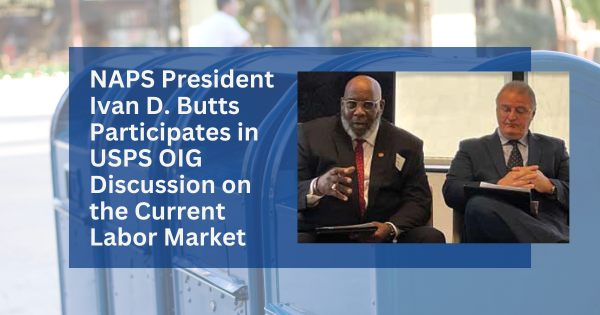President Ivan D. Butts Participates in USPS OIG Discussion on the Current Labor Market
On Sept. 12, NAPS President Ivan D. Butts joined a Postal Service Inspector General panel discussion titled, “Unboxing the Future: Job Market Trends and Their Impact on the Postal Service.” The panelists talked about the current labor market and its impact on the Postal Service and opportunities for the future.
USPS Inspector General Tammy Hull welcomed attendees—in person and online. She said the OIG has found during some of its recent field reviews that staffing shortages and inexperienced employees often contributed to mail delays. “We continue to look into workforce issues and further reexamine our staffing shortages in certain areas,” she explained. “We also will conduct research into the USPS recruitment, hiring and retention practices and candidate experience.”
Keynote speaker Dori Allard, assistant commissioner for Industry Employment Statistics at the Bureau of Labor Statistics, provided various statistics regarding employment. The panelists in addition to President Butts were Simon Storey, USPS vice president of Human Resources; Tracey Therit, chief Human Capital Officer, Department of Veterans Affairs; and Kathy Siviter, assistant executive director of the National Association of Presort Mailers.
Butts noted that the trend with millennials and Generation Z employees is they are more transitory and look at how a job fits into their expectations of employment. “It’s not unusual for these workers to have six or seven jobs before they decide on a career,” he said. “They are looking for a job that fits into their lifestyle, then they move on.”
Another issue is compensation. “There’s a lot of competition with pay for this age group,” Butts affirmed. “We have to fight that battle.”
He explained that NAPS represents managers, supervisors and postmasters, which he sees as an opportunity in the onboarding process. “The hiring process takes so long with security background checks, we’re losing candidates,” he said.
Butts acknowledged that while the process has gotten better, the problem is candidates are not in front of the managers with whom they will work. “They come to the office and see a video, but they don’t really know what the work is they would have to do,” he asserted.
“When they actually see the work, some leave. We feel it’s better to get candidates in front of the boots-on-the-ground leadership as soon as possible, which will help them make a real-life decision—‘Can I do this job or not?’”
Butts later pointed out that administrative support functions in the Postal Service can be accomplished in a hybrid environment, but delivering for America requires leadership and employees to be physically present. “Just as during COVID-19, when we delivered mail and supplies to our customers,” he stressed.
During his final remarks, Butts raised the issue of why EAS employees are leaving. “The Postal Services does exit surveys,” he said. “NAPS has asked for data to try and understand why managers are leaving and going to other federal agencies.”
